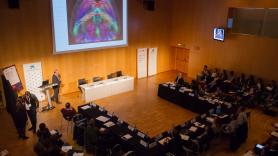2. Imaging cancer to fight it
The fight against cancer targets different stages: precise early diagnosis, proper prognosis and, of course, effective treatment. Imaging techniques play a part in each of these stages, and researchers are studying how to perfect their use in each one.
The combination of PET and CT techniques is one of the best tools to diagnose and measure the size of a tumor. It generally involves using a specific marker to see cell populations that consume large quantities of glucose, as cancer cells have a faster metabolism. Work is also being done to differentiate them, to see the heterogeneity of the tumor. As Markus Rudin explained, some of these studies are focusing on how to identify and visualize cells with hormone receptors inside breast cancer, so they can be treated with blocker drugs. This way, fluorescent techniques can be used to get a map of the initial composition and progress of the tumor over the course of treatment.
The team led by Francisca Mulero, head of the Molecular Imaging Unit at the Spanish National Cancer Research Center (CNIO) in Madrid, is working on better prognosis techniques that can also guide personalized medicine treatments. To do so, they are studying hypoxia: to what extent tumors lack oxygen. These tumors normally grow in an unstructured manner, and even though they may also form in blood vessels, they are normally not enough to provide the oxygen levels needed. Cancer can adapt to any scarcity, which also allows it to resist certain treatments: radiotherapy is less effective and it is harder for chemotherapy drugs to reach them.
By perfecting techniques that combine PET and CT scans with a specific marker, their work helps visualize and quantify the level of hypoxia in a tumor. This has allowed them to assess the efficacy of new breast cancer drugs that seek to normalize blood vessels and therefore improve the effects of chemotherapy. What they’ve seen is that if the oxygen levels in the tumor fall below a certain level, the new drugs are ineffective. This could help guide their use, excluding patients who won’t benefit from them.
Imaging techniques can also be used directly in treating tumors. For example, one of the most active areas of research is cancer stem cells, a small cell population that seems to be responsible for initiating metastasis and resisting therapies. The team led by Simo Schwartz –director of Nanomedicine at the Vall d'Hebron Research Institute in Barcelona– is working with nanomedicines that specifically target this type of cells. They use specific fluorescent markers for stem cells. This allows them to demonstrate their efficacy and behavior within the cell chaos of a tumor.
Imaging techniques are now reaching fields even more directly as treatments used every day, in surgery for example. This was explained by Quyen T. Nguyen, associate professor at the University of California San Diego, because “knowing exactly where a tumor begins and ends is really hard,” she explained. In operations to remove a tumor, several samples are often sent to the pathologist to identify as quickly as possible whether there are still cancerous cells around those that have been eliminated. This implies that the excision is almost surely incomplete.
“This makes surgery more complicate and costly,” said Nguyen. Her team has developed fluorescent markers that target proteins that are commonly found in tumors, which can then be seen during the operation. But not only that. They are also working on tools to “light up” and observe the nerves in order to help surgeons and decrease the possible side effects.
The organizers didn’t hesitate in saying that “a picture is worth more than a thousand words.” Obviously, it’s hard not to agree with them.



